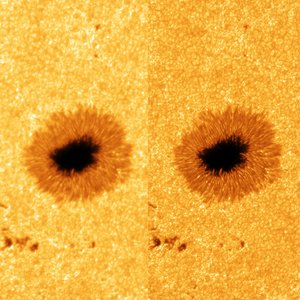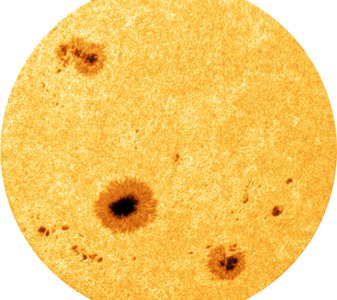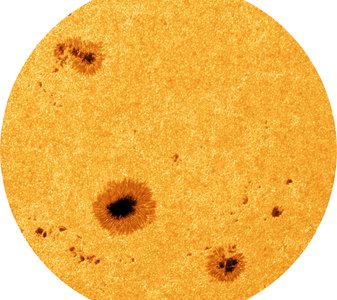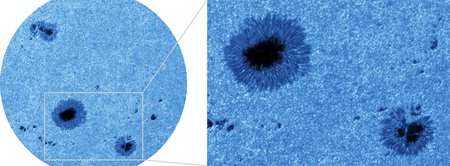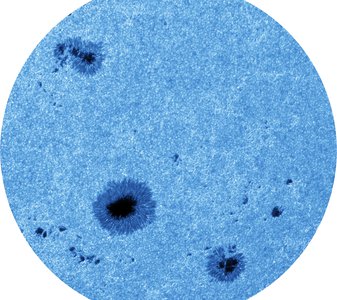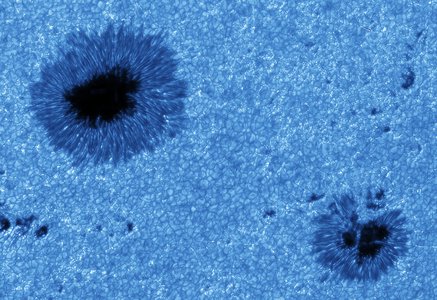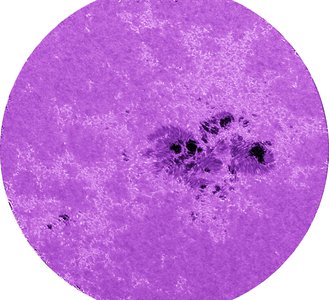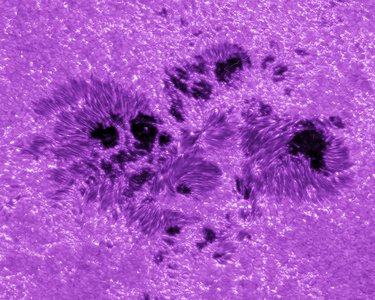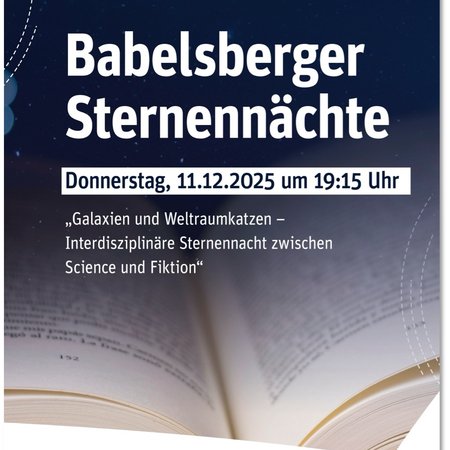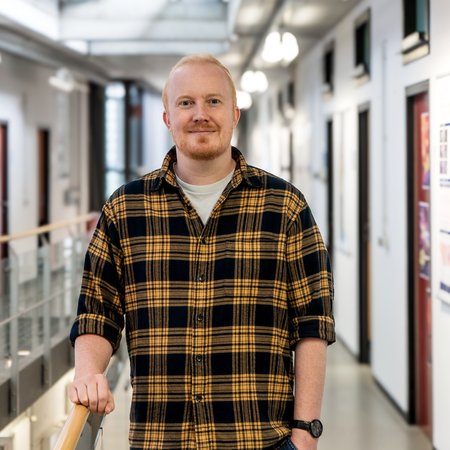The Sun Up-Close: High-Resolution Observations with New VTT Camera Technology
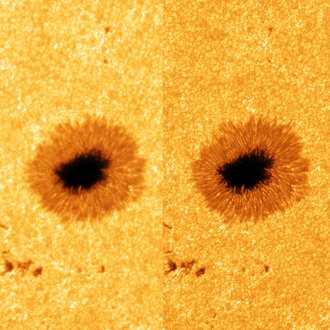
Left: Extract from a single image of the Sun, taken with the Vacuum Tower Telescope on Tenerife. Right: High-resolution image restored from 100 individual exposures captured by the new advanced camera system. The details are much sharper. The new camera system allows researchers to study large plasma streams as well as the evolution and motion of sunspots with excellent precision.
Credit: R. Kamlah et al. 2025Large and complex sunspot groups characterize the surface of the dynamic Sun during its activity cycle. A new camera system at the Vacuum Tower Telescope (VTT) at the Observatorio del Teide on Tenerife uses image restoration methods to capture small structures in active areas. This has resulted in unique, high-resolution images that reveal the smallest details in active regions of the Sun's surface.
Large solar telescopes can observe the smallest details on the surface of the Sun, but only in a small field of view. As a result, they miss the large-scale development of active regions. Smaller telescopes in space or in earth-spanning networks observe the entire solar disk around the clock, but cannot zoom into the complex and rapidly changing structures that are shaped by the magnetic field. This is where the Vacuum Tower Telescope (VTT) on Tenerife, which has been in operation since 1988, comes into play. It is characterized by a large field of view and good spatial resolution, thus closing the gap between these two types of telescopes.
With the help of the new, modern camera system of the Leibniz Institute for Astrophysics Potsdam (AIP), the entire field of view of the VTT has now been restored for the first time. For a restored image, 100 short time-exposure images with 8000 × 6000 pixels are required, which are recorded at 25 frames per second. This means that the camera system delivers reconstructed images with an 8K image resolution for the first time. The fast image sequence makes it possible to eliminate the disturbing influences of the Earth’s turbulent atmosphere from the solar images. As a result, the telescope’s theoretical spatial resolution of down to 100 km on the surface of the Sun can be achieved. Time-lapse recordings of the restored images also enable the investigation of dynamic processes on time scales of 20 seconds. The new camera system complements the HELioseismic Large Region Interferometric Device (HELLRIDE), Laser Absolute Reference Spectrograph (LARS), and Fast Multi-line Universal Spectrograph (FaMuLUS) instruments at the VTT, which are operated by the Thuringian State Observatory Tautenburg (TLS), the Institute for Solar Physics (KIS) in Freiburg, and the AIP, respectively. “In order to better understand solar activity, it is crucial not only to analyze the fundamental processes of the fine structure and the long-term development of global activity with various instruments,” says Rolf Schlichenmaier, scientist at the KIS, “but also to investigate the temporal evolution of the magnetic field in active regions.”
The new images show areas that correspond to around 1/7 of the Sun’s diameter, i.e., around 200,000 km. This makes it possible to observe large-scale structures of the active Sun such as plasma motions and sunspot groups. In comparison, large telescopes typically only provide image fields of around 75,000 km in diameter. “Our expectations of the camera system were more than fulfilled right from the start,” says Robert Kamlah, who carried out the project as part of his doctoral thesis at the AIP and the University of Potsdam. The G-band observations demonstrated how the sunspots are embedded in the supergranulation, i.e., a large-scale convective pattern. The non-radial orientation and twist of the penumbral filaments revealed the complex magnetic field structure, which was responsible for three major and many minor flares in the active region.
By using special filters, the smallest magnetic field signatures become visible as bright structures in the solar images. Time series in the light of the singly ionized calcium line at 393.3 nm and in the Fraunhofer G-band at 430.7 nm enabled the identification of areas with increased activity and the tracking of plasma motions in the active regions in two layers of the solar atmosphere (photosphere and transition to the chromosphere). In addition, the researchers investigated methods for measuring image and observation quality. “The results obtained show how, together with our partners, we are teaching an old telescope new tricks,” says Carsten Denker, Head of the Solar Physics Section at the AIP. Telescopes like the VTT can make important contributions to the study of solar activity, especially when information of a large active region and its surroundings needs to be captured, such as during solar flares and other eruptive events as part of space weather forecasting. In the future, low-cost CMOS camera systems with 8K image resolution will also play an important role for the next generation of instruments on 4-meter solar telescopes, as they will triple the field of view of current 4K camera systems.
The 0.7-meter VTT solar telescope is operated by a German consortium led by the Institute for Solar Physics (KIS) in Freiburg, in collaboration with the Leibniz Institute for Astrophysics Potsdam (AIP) and the Max Planck Institute for Solar System Research in Göttingen.
Science Contact
Dr. Robert Kamlah, +49 331 7499 406, rkamlah@aip.de
Prof. Dr. Carsten Denker, +49 331 7499 297, cdenker@aip.de
Media Contact
Tilo Bergemann, +49 331 7499 803, presse@aip.de
Original Publication
R. Kamlah et al. 2025, Wide-field Image Restoration of G-Band and Ca II K Images Containing Large and Complex Active Regions, Solar Physics, doi: https://doi.org/10.1007/s11207-025-02472-6
Partner Information
The Institute for Solar Physics (KIS) in Freiburg conducts basic research in solar astrophysics. Observations of the Sun, their interpretation using models and the development of modern instrumentation form the pillars of the institute. The aim of the scientific work of the KIS is to understand the magnetic activity of our Sun and stars with the help of spectroscopic-polarimetric measurements and their analysis, thus contributing to the unraveling of solar-terrestrial relationships.
Science Contact: Dr. Rolf Schlichenmaier, +49 761 3198 212, rolf.schlichenmaier@leibniz-kis.de
The Thuringian State Observatory Tautenburg (TLS) is a non-university research institution of the Free State of Thuringia. It conducts basic research in the field of astrophysics. The researchers at the TLS use various telescopes worldwide and in space for their observations of galaxies, stars, the Sun, gamma-ray bursts and extrasolar planets. The Thuringian State Observatory operates and uses the 2-meter Alfred Jensch Telescope for observations in the optical wavelength range and a station of the European Low Frequency Array (LOFAR) radio telescope. It also researches the Sun's magnetic field with its own solar laboratory.
Science Contact: Prof. Dr. Markus Roth, +49 36427 86351, mroth@tls-tautenburg.de
Press release of the TLS: https://www.tls-tautenburg.de/de/news/...
Images
Left: Extract from a single image of the Sun, taken with the Vacuum Tower Telescope on Tenerife. Right: High-resolution image restored from 100 individual exposures captured by the new advanced camera system. The details are much sharper. The new camera system allows researchers to study large plasma streams as well as the evolution and motion of sunspots with excellent precision.
Big screen size [1000 x 1000, 200 KB]
Original size [3519 x 3519, 1.4 MB]
Single image of the Sun, taken with the Vacuum Tower Telescope on Tenerife. The image diameter corresponds to approximately 200,000 kilometers on the surface of the Sun.
Big screen size [1000 x 889, 170 KB]
Original size [6752 x 6004, 3.2 MB]
High-resolution image restored from 100 individual exposures captured by the new advanced camera system. The details are much sharper. The image diameter corresponds to approximately 200,000 kilometers on the surface of the Sun.
Big screen size [1000 x 889, 210 KB]
Original size [6680 x 5940, 4.1 MB]
Restored short-exposure G-band image of simple sunspots and pores in the active regions NOAA 13685 and NOAA 13686 taken with the VTT on 2024 May 24. The coloring of the images corresponds to the observed wavelength at 430.7 nm.
Big screen size [1000 x 370, 110 KB]
Original size [6484 x 2400, 2.3 MB]
Restored short-exposure Ca II K image (entire field of view and region of interest) of a very large and complex group of spots in the active region NOAA 13691 on the Sun, which was recorded with the VTT on 2024 May 28. The coloring of the images corresponds to the observed wavelength at 393.3 nm.
Big screen size [1000 x 405, 110 KB]
Original size [5916 x 2400, 1.9 MB]
Restored short-exposure G-band image of simple sunspots and pores in the active regions NOAA 13685 and NOAA 13686 (entire field of view) taken with the VTT on 2024 May 24. The coloring of the images corresponds to the observed wavelength at 430.7 nm.
Big screen size [1000 x 889, 230 KB]
Original size [6680 x 5940, 4.3 MB]
Restored short-exposure G-band image of simple sunspots and pores in the active regions NOAA 13685 and NOAA 13686 (region of interest) taken with the VTT on 2024 May 24. The coloring of the images corresponds to the observed wavelength at 430.7 nm.
Big screen size [1000 x 685, 190 KB]
Original size [3500 x 2400, 1.1 MB]
Restored short-exposure Ca II K image (entire field of view) of a very large and complex group of spots in the active region NOAA 13691 on the Sun, which was recorded with the VTT on 2024 May 28. The coloring of the images corresponds to the observed wavelength at 393.3 nm.
Big screen size [1000 x 911, 200 KB]
Original size [6585 x 6004, 3.0 MB]
Restored short-exposure Ca II K image (region of interest) of a very large and complex group of spots in the active region NOAA 13691 on the Sun, which was recorded with the VTT on 2024 May 28. The coloring of the images corresponds to the observed wavelength at 393.3 nm.
Big screen size [1000 x 800, 200 KB]
Original size [3000 x 2400, 890 KB]
